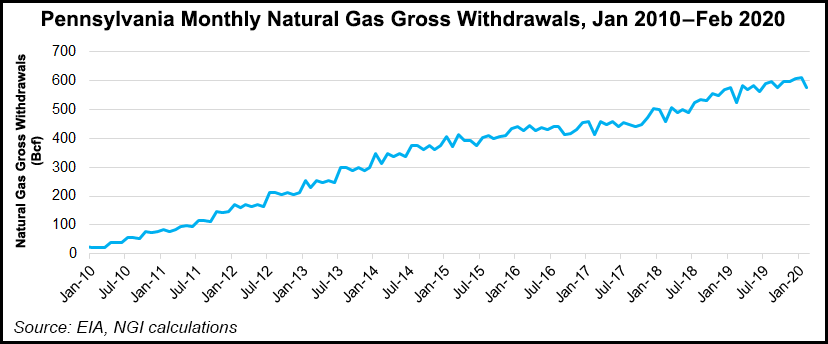Utica Shale | E&P | Marcellus | NGI All News Access | NGI The Weekly Gas Market Report | Regulatory
Pennsylvania VOC Emission Crackdown Eyed from Existing Natural Gas, Oil Infrastructure
Emissions from Pennsylvania’s existing natural gas and oil infrastructure, including at Marcellus and Utica shale sites, are facing more stringent oversight under a draft proposal.

The draft rulemaking covering volatile organic compounds (VOC) published by the Environmental Quality Board (EQB) for public comment over the next two months would be the first to address VOC emissions from the existing infrastructure.
The Pennsylvania Department of Environmental Protection (DEP) initially issued a proposal in late 2018 to curb emissions from existing production and midstream operations, and late last year the ECB gave it the green light.
Five source categories would be affected by the proposed VOC rules:
The draft rules increase oversight for VOCs, requiring operators to adopt rules covering reasonably available control technology, aka RACT, as well as emission limits for gas and oil sources. In addition, the rulemaking would add federal Clean Air Act definitions to support the measures, requiring the U.S. Environmental Protection Agency to sign off to revise the State Implementation Plan.
According to the DEP, the proposed rulemaking “will provide consistency among all oil and natural gas sources…for monitoring fugitive emissions components,” by including monthly Audio/Visual/Olfactory inspection requirements and quarterly leak, detection and repair (LDAR) inspection requirements.
“This proposed rulemaking is also consistent with Gov. Tom Wolf’s strategy to reduce emissions of methane from the oil and natural gas industry in this commonwealth,” ECB wrote. Wolf’s strategy, announced in early 2016, committed the DEP to develop rules for existing sources to reduce leaks at existing gas and oil facilities based on RACT recommendations.
“The strategy also states that the commonwealth will reduce emissions by requiring LDAR inspections and more frequent use of leak-sensing technologies. This proposed rulemaking fulfills that part of the strategy.”
The proposal only requires VOC emissions to be reduced, but DEP noted that a “co-benefit” would be lower methane emissions, as VOCs and methane are emitted from gas and oil operations.
“This proposed rulemaking strives to ensure regulatory certainty for the oil and natural gas industry in this commonwealth,” according to the DEP. Regulators estimate there are 89,320 unconventional and conventional gas and oil wells across the state, with 8,403 unconventional and 71,229 conventional wells in production.
“These facilities also include approximately 435 midstream compressor stations, 120 transmission compressor stations and 10 natural gas processing facilities…whose owners and operators may be subject to the proposed VOC emission reduction measures, work practice standards and reporting and recordkeeping requirements.”
Implementing the rules, if enacted, would come at a cost of about $35.3 million a year, regulators noted.
“However, implementation of the proposed control measures would also potentially save the oil and natural gas industry about $9.9 million/year due to a lower natural gas loss rate during production,” regulators noted.
“Of the 71,229 conventional wells reporting production, only 303 are above the 15 boe/d production threshold” as reported in DEP’s 2017 oil and natural gas production database, which would require fugitive emissions to be regulated.
“For sources located at a natural gas well site, the anticipated cost to comply with the requirements would be based on the sources present at the site, the applicability of those sources and the type of control used to comply.”
Most of the expected costs would be from the new regulatory requirements, “but many of the costs associated with this proposed rulemaking are from common sense practices and controls that operators are already implementing,” DEP noted.
“Some examples include periodic inspections, which can prevent releases, which in turn prevents environmental damage and significant financial losses for the operator.” Cost savings also are expected to be achieved because of the rulemaking.
Most small business stationary sources likely are below the applicability thresholds, regulators noted. Overall, state regulators do not think the new rules would have “any significant adverse impact on small oil and natural gas operators.”
The nonprofit Environmental Defense Fund (EDF), which works with oil and gas producers to help reduce wellsite emissions across the country, praised Wolf’s leadership to move the rulemaking forward.
“Our analysis found that Pennsylvania oil and gas operators emit more than 1 million tons of methane annually,” said EDF’s Dan Grossman, senior director of State Advocacy. “Cutting methane pollution from existing oil and gas sources is critical to meeting our climate goals.”
However, Grossman recommended DEP strengthen the draft rule “to address emissions from across the oil and gas supply chain — including low-producing wells that are responsible for half of all emissions statewide.”
Natural gas is expected to remain “a large part of Pennsylvania’s electric generation for the foreseeable future,” said Pennsylvania Environmental Council President Davitt Woodwell.
Therefore, “we need to ensure that we don’t lose the progress we’ve made in reducing carbon emissions…This rulemaking moves us closer to a sustainable and economically viable energy portfolio by holding producers to a reasonable standard that can be met at little or no cost to them.”
To submit comments on the proposal, which are to be taken for about two months, visit the DEP website and select “Public Participation,” then “Environmental Quality Board.”
© 2024 Natural Gas Intelligence. All rights reserved.
ISSN © 2577-9877 | ISSN © 1532-1266 | ISSN © 2158-8023 |
